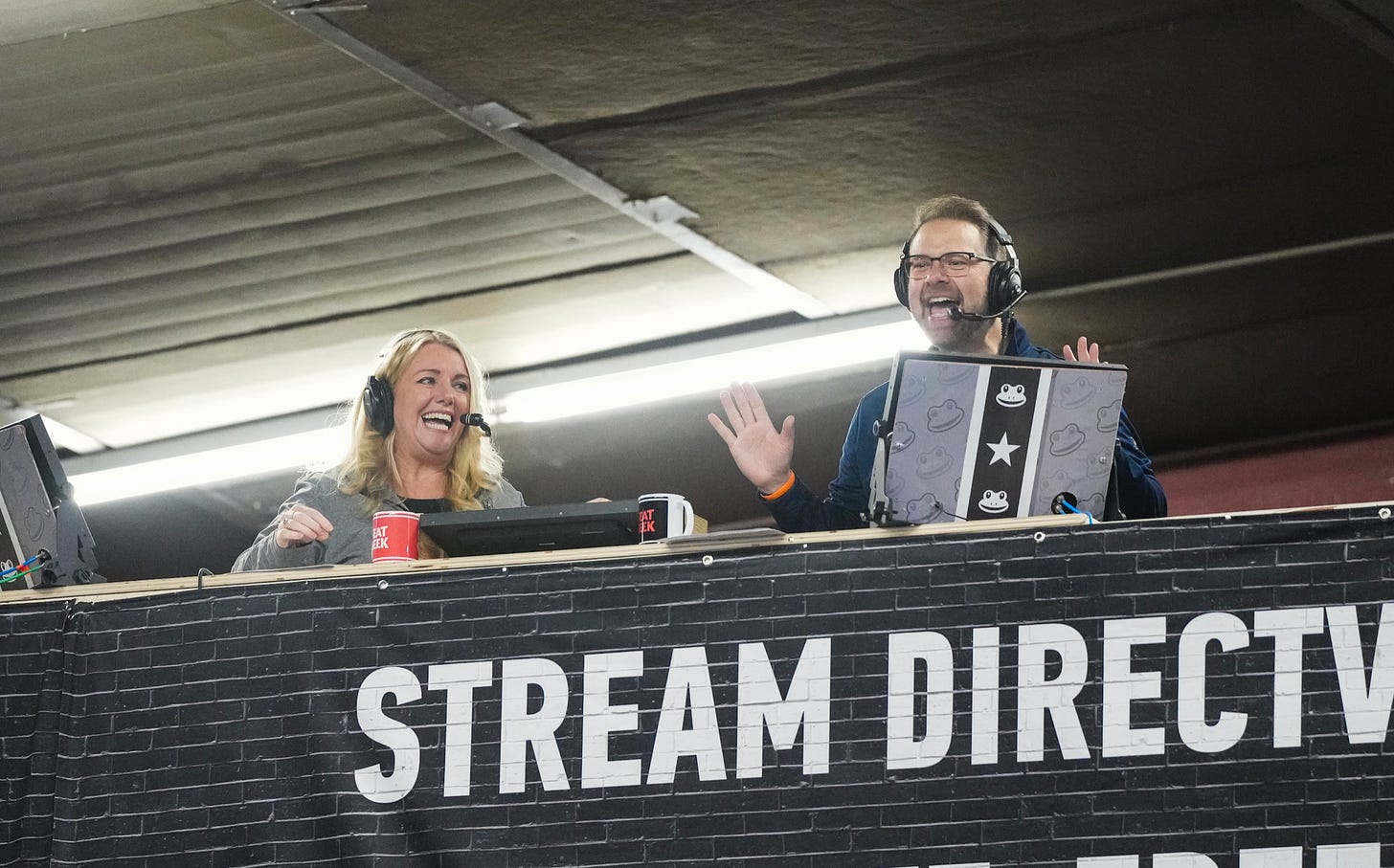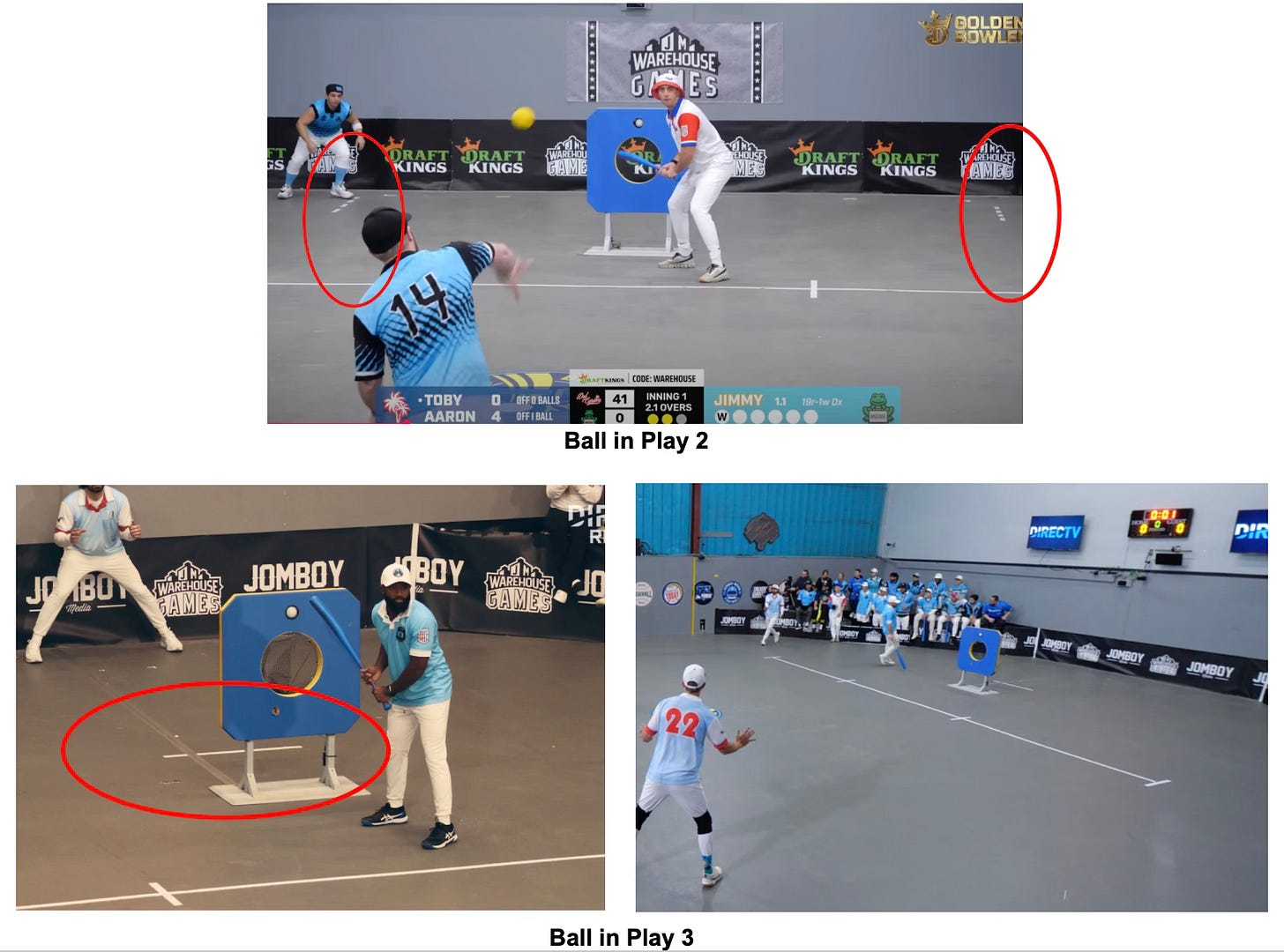Ball in Play 3: New and Updated Rules
Below are the rules we’re using for Ball in Play 3 and the rationale behind them.
For new members joining our community, it's essential to understand that we continuously refine and adjust our rules. This means we might occasionally cross a line and then take a step back to update our approach. This way of doing things is an integral part of the Warehouse Games culture, allowing us to grow and improve over time.
The essence of backyard and neighborhood sports lies in adapting games to your surroundings and abilities. It's about creativity and flexibility.
These informal games often lead to intense emotions. You might experience heartbreak or get into a heated argument with your best friend because you create a rule stating that all branches are considered part of the “foul pole tree.” Then, when you hit a home run off a branch hanging 10 feet left of the tree trunk, your best friend says, “That's bullshit, I don't even know why we made that rule! I never wanted it.” You might respond, “Fine, we'll finish this game with the rule, then play the next one without it.”
At Warehouse Games, we embrace this spirit of adaptation and creativity. We're not trying to avoid unconventional elements – we're celebrating them. Our venue has its own quirks, like a ceiling that "eats" balls and beams that cause unpredictable ricochets. We're inventing entirely new sports! These unique features and the improvisational spirit are what make Warehouse Games special and exciting.
The goal of creating Ball in Play has never been to replicate the experience of watching cricket. That wouldn’t be realistic—we’re in a warehouse, using a baseball bat to pitch and swing. Instead, the focus has always been on emphasizing running, defense, and diverse strategies—elements that are not fully integrated into our version of blitzball.
The new rules aim to make the game more dynamic and adaptable to different batting styles and strategies. Some players may always aim for big swings, while others might adopt a safer approach, minimizing risks while still contributing to the team. Game situations will dictate these strategies: sometimes aggressive swings are necessary, while other times playing it safe is the better option. This balance of strategy is what the game is designed to achieve. Below are the rules we’re using for Ball in Play 3 and the rationale behind them.
Game Structure
Each game consists of 4 innings (2 baseball innings).
Each inning consists of 4 overs.
Each Over consists of 6 Good Balls
Bowling Changes
What has changed:
The mound has been moved back ~2 feet.
The speed limit is set to 39mph and below. (This is the same as before)
Why:
Allows bowlers to put a little more on the ball. More room for pace/velo. More room for spin/break.
Almost every ball 41mph+ ball last BIP went for a wicket or dot ball. It felt like we had the speed at the proper place.
Strikers End Wicket
What has changed:
We’ve gone from three giant blue wickets to just one giant blue wicket.
Why:
Last year's BIP we had some runouts that were a little too easy and as a result, batters deemed it too risky to go for the single. We don’t want this to be a static game of boundaries and dots only. We want dynamic scoring. So making the target for the fielders slightly smaller should allow for more singles and batters trading strike.
Dead Ball
When a wicket is taken the play is dead
The play will be considered dead when both runners are safely in their creases and a defensive player, positioned near the striker's end, has secure possession of the ball.
The umpire will signal this to the teams.
Play IS NOT dead after a failed runout attempt
If the wicket at the bowler's end has fallen over, and another opportunity for a run-out arises, the fielding team must hit the fallen wicket on the ground to complete the dismissal.
More Opening Batters
What we changed:
Each player will be part of an opening partnership. So the two players that open the batting in a team's first inning will not open the batting in the second.
What it changes:
Teams may utilize different strategies.
Do you start your two best hitters in the first inning and risk them not getting into the second until too late and with too much pressure?
Do you start your best hitter in the 1st inning and your 2nd best hitter in the second inning to spread out the attack.
Do you start your two weakest hitters in the first inning so you save the best two for the second.
The team that fields first will have the benefit of knowing where the game is at before they make their decision.
Why:
Showcases more of our players and guests
Adds a strategy element
Removes the strategy of batters getting out on purpose or retiring themselves so they open the next inning.
* After a wicket, the new batter will always be on strike to face the next ball.
More Ways To Score
What we changed:
6 Runs: You hit the Can or the Logo
4 Runs: High Boundary on the bowler's end.
2 Runs: Low Boundary on the bowler's end.
2 Runs: Entire back wall on the keeper's end.
1 Run: Over the small wall and into the crowd
+1 Run: Square gray walls, only in addition to a successful run. (between the yellow lines)
Why:
With high boundaries worth 6 runs and low boundaries worth 4 runs, the game became less dynamic and more predictable:
Batting strategy became one-dimensional:
Batters focused solely on hitting boundaries
Little emphasis on strike rotation or running singles
"Stand and deliver" became the dominant approach
Fielding strategy became defensive:
Teams prioritized protecting the back wall
Fielders essentially played a "goalie" role
Game statistics reflected this static play:
80% of good deliveries resulted in either a boundary or a dot ball in 2024 Captains league
This high percentage indicates a lack of nuanced gameplay
The lack of incentive for singles and strike rotation led to a less dynamic game, with batters primarily aiming for boundaries on every ball. This approach reduced the strategic elements of the game, such as;
building partnerships through smart running between wickets.
protecting against good bowlers and attacking the less-than-bowlers.
Trading strike to keep the ‘hot hand’ in the crease.
What it changes:
Batters now have multiple ways to score 2 runs:
Hit the bowler's end wall: 2 runs, retain strike
Hit the keeper's end wall: 2 runs, retain strike
Hit square walls and run: 2 runs, exchange strike
This new system allows for more diverse strategies
For batting teams, partnerships can be managed more effectively
Weaker batters can use bonus walls to score and return strike to stronger partners
Teams can prioritize keeping wickets by targeting bonus walls early in innings
Later in innings, teams can switch to targeting high boundaries (4 runs)
For Fielding Teams, defensive strategies must be more dynamic
Protect bonus walls against weaker batters
Adjust field placement based on batter strengths and game situation
For overall game dynamics, batters must read the field and adapt
Take what the defense offers (e.g., hit forward for 2 if bonus walls are protected)
Switch to big hits when fielders collapse to protect bonus walls
This new system encourages more strategic thinking, adaptability, and diverse gameplay compared to the previous "stand and deliver" approach.
High Boundaries are still the key to winning games.
The difference between high and low boundaries has increased
High boundaries are now worth twice as much as low boundaries
This means that batters capable of consistently hitting high boundaries safely will score at a much higher rate.
Teams can also score three runs on a single ball by utilizing the bonus wall. This strategy involves:
Hitting the ball against the wall
Running between the wickets twice
This technique requires:
Excellent communication between batsmen
Precise bat control
High levels of stamina
The repeated sprints between wickets can be physically exhausting for the batsmen. Therefore, this strategy requires both skill and endurance to execute successfully.
*Bonus Wall
If a fielder attempts to field a ball and, in doing so, inadvertently redirects it into the bonus wall, the play will be treated as if the batter had hit the bonus wall. This means that the batting team will receive the associated runs, just as if they had intentionally hit the ball into the bonus wall.
If a fielder gathers and controls the ball before it hits the bonus wall and then attempts to make a play elsewhere (e.g., throwing to run out a batter) and during this attempt, the ball hits the bonus wall the play will NOT be considered a bonus wall hit.
Other notes
*If a batted ball goes into the crowd it will be worth 1 run and the batters trade strike.
*If a ball gets stuck on top of the side wall it is worth 1-run and the batters trade strike.
*The red beams are part of the wall/zone behind them.
More Overs
What we changed:
Innings will have 4 overs and 3 outs now instead of 3 overs and 3 outs. Only 1 golden bowler is allowed per inning.
What it changes:
A maximum of 3 different players will have to bowl an over now.
Without earning a golden bowler, all four players may have to bowl an over.
The best bowler can only make up 50% of the overs instead of 66% like before.
Why:
We had far too many teams getting bowled out (inning ends before they face all their pitches). That’s not a good product.
By adding a 4th over it really puts the emphasis on ‘building the inning’. Not every swing should carry great risk. If the opponent has a dominant bowler, maybe it’s in the best interest to just survive that over and attack the next bowler.
You want to do whatever you can to face all 4 overs. In past editions, getting bowled out in the second over wasn’t terrible. Now, that’s pretty terrible because the other team knows they can play it safe and score enough runs simply by seeing every ball.
Other benefits:
More players get a chance to bowl.
Get to showcase more of our players
Teams are only as good as their 3rd and 4th bowlers
One bowler can’t dominate the game.
No Keeper Limit
What it changes:
Keepers will no longer have to start off to the side and then run to the middle. They just have to start outside of the crease.
Why:
Keepers can be in a better position to read the batter's motion and protect the bonus wall on both sides
We had two injuries last year due to running, stopping and running in a new direction.
Keepers should be the most athletic players on the field, a good keeper should be able to make catches and stops in the full horseshoe around the batter. This allows the athleticism to show itself more.
Wides
Any ball bowled/thrown that does not come into contact with the blue zone, the magic hole, nor the bat of the batter.
*see BBW below for rulings on balls that hit the batter's body.
LBW (or BBW, Body Before Wicket)
What we changed:
This isn’t a change, but we have more firm rules now.
Batters have to try to avoid being hit in the body with the ball. (Unlike blitzball)
If a bowled ball hits the batter in the body and there is *any indication that it would have hit the blue zone, the ball will be considered a dot ball and the batting team will receive a warning.
Each team is given one warning per inning. The second offense will be a wicket.
*any indication: If the ball hits batter while he is standing in front of the blue zone or hits a part of his body that is in front of the blue zone (hanging elbow, head leans, leg kick, etc;) then any ball that hits him (unless clearly below the zone) will be a dot ball and a warning or wicket, if a warning has been issued. If the batter is standing to the side of the zone (baseball setup) and the pitch thrown is breaking/swinging in the direction of the zone it will be a dot ball. All that is needed is a 1% chance that it may have swung/broke into the blue.
Why:
To avoid chaos
Running
Runners must CROSS the white line before the defense hits the blue zone or knocks the ball off the wicket to be deemed safe.
Nonstrikers-end-runners must remain behind the line entirely before the ball is released from the bowler's hand.
In previous seasons, just the bat could be behind the line. Now, no part of the runner can be in front of the line.
Runner interference
If runners interfere with the defense while standing still in their crease or running naturally to the other side it will not be ruled interference.
If runners intentionally interfere with the defense's ability to make a play, it will be a ruled wicket.
If runners unintentionally interfere with the defense's ability to make a play and are not in their running lane or standing still in their crease it will be up to umpire and booths discretion to award either a wicket or a dot ball and a warning.
The second such infraction will be a wicket
If the interference comes after successful runs have been scored the runs from before the interaction will count.










Has anybody clarified what ball is used?
So we aren't gonna address that bunting to the wall is literally all you should do with these rules? And we say it play out already...